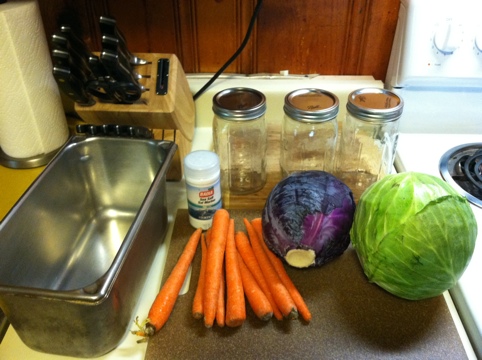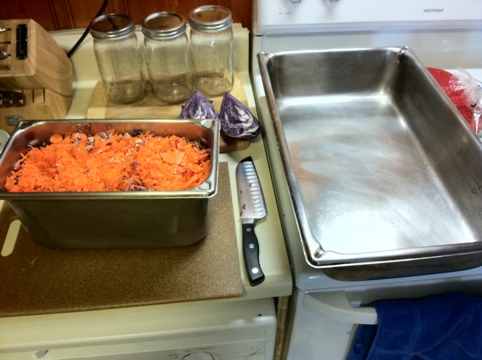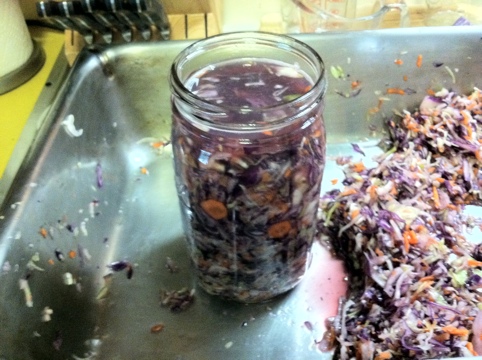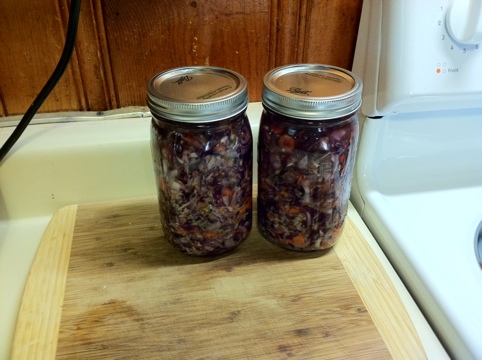by Todd Walker
I always wipe down the shopping cart handle with the handy sanitizing wipes at the grocery store. I’m doing my part in the war on germs being waged in our society. Anti-bacterial soap, anti-bacterial hand sanitizer are only the tip of our modern microorganism warhead. Pasteurized and irradiated food is a relatively new practice. Sterile is good, right?
Fermented foods have sustained humans for thousands of years. When it comes to our gut flora, exposure to bacteria is a good thing. Fermented foods offer the sterile gut a healthy dose of probiotics to help balance our intestinal flora. In a prolonged emergency, the skill of fermentation will become very useful – even life saving. When the lights go out, a lot of sub 40 degree food will go to waste.
My sauerkraut will last for years if it had to. Around my house, it doesn’t stand a chance lasting a year. If you hate bland, over-processed store-bought kraut, this stuff will make your taste buds and gut flora smile!
Here’s a healthy alternative for storing the abundance of produce from this years growing season…
Make Your Own Down and Dirty Sauerkraut
A.) Gather the Stuff
In this batch, I used one head of white cabbage, one head of red, and about 9 carrots, and some sea salt. You’ll need 2 or 3 wide mouth quart jars with lids. Always use glass to store the kraut to prevent acidic reactions with metal material. I used stainless steel pans to mix the kraut, but only leave it in long enough to mix it. You should really use non-reactive containers in the whole process.
B.) Shred the Stuff
Shred the cabbage or other vegetables you want to add to your kraut. I use a food processor for a down and dirty (quick) method. Some folks like to slice it with a knife to get the desired length on the kraut. If you’re fortunate, you own a cabbage cutter.
C.) Spread the Stuff
Spread a layer (about an inch or so) into big container. Sprinkle some sea salt over the layer. How much? I don’t know. I don’t make stuff with exact recipes. You may also like to add a tablespoon of caraway seed. I’ve never tried it, but have heard it’s good. Keep adding layers of cabbage and salt until all the veggies are in the container.
Food processor with some red cabbage below.
D.) Squeeze the Stuff
I put all the shredded future kraut into a larger container. You should let the mixture set for about an hour (some recommend 24 hours – but who’s counting) to let the salt begin drawing the moisture out of the veggies. I didn’t wait since I used stainless steel this time. I just started squeezing the juice out. You’ll notice the brine starting to pool at the bottom of your container. Keep squeezing. Some folks call it messaging. I brutalized my kraut for about 20-30 minutes.
E.) Pack the Stuff
Once there’s a fair amount of brine in the bottom of your container, start filling the quart jars. I try to leave about an inch of head space. As you fill the jar, you’ll want to use a utensil to pack the kraut layer by layer. I used a big wooden spoon. The micro lovelies like it packed tight for better fermentation.
F.) Brine the Stuff
Once filled, make sure the veggies are covered completely with brine. I’ve seen people use a piece of cabbage to cover the kraut with a weight of some kind. I didn’t use that method. I just made sure I had enough brine to cover. Use any left in the big container to pour over the jar contents. If you don’t have enough brine, dissolve a little sea salt in distilled water as your brine. Pour enough to cover.
Cap the jars with lids and screw the rings down loosely so gas can escape. Sit containers on a counter out of direct sunlight. Check the jars every day or so to make sure the brine is still covering the kraut. You may have to press the kraut down on each check up to ensure it stays submerged.
G.) Label the Stuff
Label the lid with the date of processing. Put it away and let nature do the rest. I let this batch sit for about a week. I just opened a jar and enjoyed its goodness.
I just found 4 crocks at a yard sale this morning. I paid seven bucks for the whole lot. I plan on using the largest on my next batch of sauerkraut.
Do you make your own sauerkraut? Share your tips and recipe in the comments.
Keep Doing the Stuff of Self-Reliance,
Todd
P.S. – You can also keep up with the Stuff we’re Doing on Twitter, Pinterest, Google +, YouTube, Instagram, and Facebook… and over at the Doing the Stuff Network.
P.P.S – If you find value in our blog, Dirt Road Girl and I would appreciate your vote on Top Prepper Sites! You can vote daily by clicking here or on the image below. Check out all the other value-adding sites while you’re there… 
Thanks for Sharing the Stuff!
Copyright: Content on this site (unless the work of a third-party) may be shared freely in digital form, in part or whole, for non-commercial use with a link back to this site crediting the author. All links in articles must remain intact as originally posted in order to be republished. If you are interested a third-party article, please contact the author directly for republishing information.
















Pingback: Individual Preparedness Program: My Primal Preparedness Pantry « Survival Sherpa
Mmmm good. I got a homemade jar from a local foraging expert last week and it was awesome. Will be following your recipe this week.
LikeLike
Pingback: 7 Great Handmade Preparedness Christmas Gifts « Survival Sherpa
So thats it? no sealing the lids later? No heating to eat? Just eat it this whay ? can you cook it like city folk do ? How long will it keep?
Thanks
LikeLike
Gregg, that’s all there is to it. Seems too simple doesn’t it. Captain Cook used sauerkraut from barrels 20 plus weeks old on his ship. My last batch made this summer has lasted just fine in the fridge. It’s alive…literally. Cooking it kills all the friendlies. Eat it “raw” and it’ll be so nice to your colony of gut flora 🙂
I read one guy that had a jar in his basement that was four years old. He scrapped the mold off the top and ate it. Not endorsing his method here. But it lasts indefinitely. Cheers!
LikeLike
how long does does the krout need to ferment?
LikeLike
Depends on the temperature. You want the room temp in the 70’s. My last batch quit bubbling in about a week. It’s done when the bubbles stop. Some say it takes 3 to 4 weeks.
LikeLike
Good stuff indeed. I make mine with a bigger mix of veggies; cabbage/cauliflower/carrots/turnips/onions/garlic/hot peppers…pretty much any of the root crops of the fall. I use a Harsch fermentation crock as I got tired of scraping the mold off the top.
For anyone looking to try this, the cabbage gives off a sulfur smell for about a week. Smells like a toilet there for a while. I pull my veggies out at about six weeks and put them into quart jars. I also prime the mix with 1/4 cup of kefir–curds and whey both. Have you tried Kefir? That’s another very good probiotic.
LikeLike
Never tried a Harsch crock. Adding the kefir curds sounds like it would kick up the probiotics. I drink kefir now but have made my own yet. Got any good recipes for homemade kefir.
Thanks for the input Bill!
LikeLike
For homemade Kefir, I usually use it as a smoothie. I put berries, bananas, peaches or whatever in a blender. Add Kefir to cover it, blend it up, add brown sugar to taste–usually a tablespoon or two. If you let this blend sit for a few hours, it gets really fizzy and yeasty tasting.
I mentioned I used Kefir as a starter in my crock, not just to up the probiotics, but the bugs in Kefir also ensure that nothing bad will get cultivated. I’m gluten intolerant so I don’t use it in baking but I have friends that swear it makes the best sourdough starter and sourdough pancakes.
BTW, if you’re drinking store bought Kefir, that is a real pale imitation of the real thing, both in appearance and taste.
LikeLike
I drink store bought for now. We want to make our own soon.
LikeLike
Pingback: How Many Pills Until Pharmageddon? « Survival Sherpa
Wow that was unusual. I just wrote an very long
comment but after I clicked submit my comment didn’t appear. Grrrr… well I’m not
writing all that over again. Regardless, just wanted to say great blog!
LikeLike
Thanks for not giving up on the comment. Sorry you lost your first comment. Glad you like the blog!
LikeLike
Pingback: How Many Pills Until Pharmageddon?
Pingback: Arm Pit Probiotics and DiY Deodorant « Survival Sherpa
Pingback: Making Yogurt: Experiments 1-4 « Survival Sherpa
Can you just warm the kraut a bit? At what temp would it kill the good stuff. We’ve been making and eating it forever but always hot. Never made the connection between heating and killing the “friendlys”. DUH!
Not sure I could get the guy to even try it room temp.
Going to try the onion next to the bed too! Lots of good info here. THANKS!
LikeLike
Hazel, heating fermented foods of any kind will kill the the bacteria you want in your gut 😦
I eat it cold out of the fridge or at room temp as a side. It’s still nutritious if you heat it, but you lose those friendlys when it’s hot. any temp over 100 degrees is bad for the good stuff 🙂
Thanks so much for stopping by and please come back often.
LikeLike
Hi there, Survival Sherpa! I agree with your advice about consuming (all) fermented foods/beverages without heating them. Research leads me to believe that what we eat/drink should be neither too cold nor too hot when consumed for many easily understood reasons.
Upon learning that heat can potentially destroy the good bacteria I’ve been cultivating with tremendous TLC.. making kefir milk, yogurt, kimchi and sauerkraut here at home, it seemed more sensible to bring all the hot stuff I’m about to eat/drink down to around 100F (using a food thermometer to check the temperature) and then add the refrigerated fermented yummies to the formerly hot stuff. There’s not one meal I eat that doesn’t include fermented foods and/or beverages and I’m convinced that’s one of the reasons I’m not beset with many of the ills my peers suffer — I’m in the WAY over 65 age group.
To everyone who reads your blog, I would like to suggest that learning how to ferment veggies as well as learning how to make fermented dairy products is VERY easy. Read Sally Fallon’s “Nourishing Traditions” and follow her directions. I did and that’s how I learned.
Living kefir grains can be gotten from most anyone who makes their own kefir milk (I got my initial kefir grains from a lady I met at an organic foods market years ago and I’ve kept them alive) — just keep asking and you’ll find somebody who will happily share!
Making your own yogurt is so simple and you’ll not only love the taste and texture (especially if you strain it and enjoy that “Greek Yogurt” consistency), but you can add your own gently processed fruits and spices. YUM!
Keeping your kefir and yogurt cultures alive for future batches is easy, too.
As you, Survival Sherpa, already know — sauerkraut making isn’t hard to do… neither is making kimchi. The only hard thing I find about it is trying not to eat/drink it all or give it away before the next batches are happily bubbling and only a day or so away from maturity.
Best wishes to all.
LikeLike
Pingback: The Top Ten Posts of Our First Year! | Survival Sherpa
Wow, fantastic blog layout! How long have you been blogging for?
you make blogging look easy. The overall look of
your web site is excellent, let alone the content!
LikeLike
Pingback: Fermented Foods: Feeding Your Second Brain | Survival Sherpa
This page truly has all of the information and facts I needed concerning this
subject and didn’t know who to ask.
LikeLike
Pingback: Fermented Foods: Feeding Your Second Brain | The Daily Sheeple
Hey, thanks for providing the making process of Sauerkraut. I’ll ask my mom to make this. I really haven’t tested it. I will test it out.
LikeLike
Pingback: Random Acts of Prepping | Survival Sherpa
Pingback: Fermented Foods: Feeding Your Second Brain | Ready Nutrition
I followed your method over a month ago and my sauerkraut is delicious! Thanks for the inspiration!
LikeLike
Glad to hear it turned out for you! 😀
LikeLike
Pingback: The 4 Standards of SmartPrepper’s Nutrition Plan | Survival Sherpa
Pingback: 20+ Ultimate DiY Gifts to Help Load Santa’s Survival Sleigh | Survival Sherpa
Pingback: Fermented Foods: Feeding Your Second Brain | Nutritional Anarchy
Pingback: Fermented Foods: Feeding Your Second Brain - Expand your Consciousness
Pingback: It Takes A Village: 33 Awesome Projects For Preppers - The Daily Coin
Great information. Lucky me I ran across your website by chance (stumbleupon).
I’ve saved it for later!
LikeLike
Is this stuff the same as Korean Kimchi? My brother loves it, but I’m not so adventurous. Just curious, he was in the marines, I’m a city girl.
LikeLike
No, sauerkraut, depending on what veggies you ferment, tastes different than kimchi. I like kimchi too. Have you tried it yet?
LikeLike
I have kraut in a Gartoph Schmitt crock ready to jar up today. It has been fermenting for 5 weeks. I simply discard the ‘bloom’ on top, pack in pints, lid and store in fridge. I DO NOT cook or water bath. I use cabbage and sea salt only. I will try other veggies at some point.
LikeLike
Cooking it kills all the goodies in the kraut. Thanks for sharing the stuff, Virgil!
LikeLike
I used two of my crockpots. The biggest one to mix and work the cabbage then I’m letting it ferment in a smaller one so everything can be submerged.
LikeLike
Good idea, Gloria. Thanks for sharing the tip!
LikeLike
I’m very pleased to discover this site. I wanted to thank you for your time just
for this wonderful read!! I definitely liked every little bit of it and i also have
you saved to fav to see new things in your blog.
LikeLike
Pingback: Get Your Gut In Shape: Down and Dirty Sauerkraut - The DayOne Gear Blog
Pingback: Made by Hands: Make it or Buy it? | Survival Sherpa
Pingback: Made by Hands: Make it or Buy it? | OffGrid Survival Website
Pingback: The Benefits of "Rotten" Food - Fermentation, Fermented Foods - Health
growing up my father made sauerkraut in crocks in the basement, that was so many years ago, we have a family joke about why the garage was built to cover one of my fathers spoiled kraut batches, I make small batches now but have made batches as large as 70 pounds, I always put my caraway seeds in just before canning, and make a variety of kraut from red and green cabbage along with Kim-chi, I always enjoy reading tips on making fermented foods, good article!
LikeLiked by 1 person
Once it is done, do you just refrigerate? How long will it last?
LikeLike
You can refrigerate but it is stable at room temp. That’s the beauty of fermentation. I’ve heard stories of it lasting years but mine has never had that kind of life. It’s gets eaten before a year’s time.
LikeLike
hi!
I just found your site and am readig from one end to the other…
I am from Austria and grew up with hommade Sauerkraut (my granny made it in a large earthenware pot (some 20 gallons).
What really struck me in this description was that the carawa seeds are optional
Caraway seeds really improve the digestability of any cabbage (especially raw Sauerkraut) and helps you emit a lot less gases.
So adding caraway seeds can be considered environmental-friendly (both ecological and social)…
Yours,
Andy
LikeLike
Point well taken and welcomed, Andy! 🙂 Thanks for the support and comment.
LikeLike
Sounds easy to do. I will have to try it. I am wondering if using one of those pre-packaged bags of cabbage- slaw mix would work too. It mixes the cabbage, red cabbage, and carrots for you. I know lazy, but I want to make a small batch as I’m the only one who’ll eat it. 🙂
LikeLike
Heck yeah! Should work. Let us know how it turns out for you, please.
LikeLike
I will! Will give it a try this weekend.
LikeLike
So I have about one pint made as a test jar and used store bought bagged pre-cut Cole slaw mix- I made some Cole slaw too – It made a nice brine and I have a lose fitting cap on the jar. I am assuming you mean put it away, but not in the fridge. Will report back in about a week or so. 😃
LikeLike
Hi There!
I said I’d update you on how this turned out. I started with a store bought ( 99 cent store bought) bag of pre- mixed cabbages and carrots, let it sit for a few weeks, added a spoonful of store bought sauerkraut, like a starter, and then a few weeks later I cut up a whole cabbage head into it. I just taste tested it and wow! It’s good! A little too salty for me and I will have to adjust the salt content, but it’s very good! Can you make it without the salt or very little salt at all? I wonder about that.
Also, I’m wondering about canning it. Would a plain water bath canner work and for how long?
thanks,
Oleeta
LikeLike